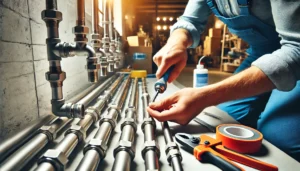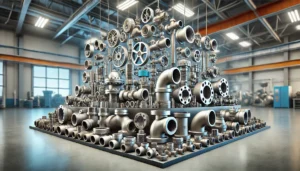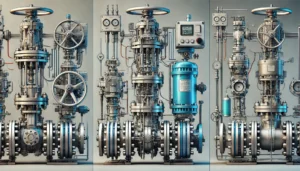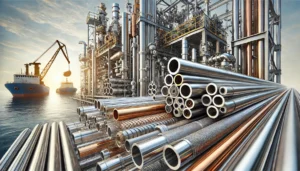Pipelines allow to move oil, gas, water and chemical substances over distances in a quick, cheap and economic manner. Depending on geographic position and their relevancy, two main types of cross-border infrastructures are defined, which are sub-sea and above-ground pipelines. Whilst the general function may be the same, developmental aspects differ widely such as design, materials used, engineering problems faced and also the maintenance after construction.
This blog will discuss the last two aspects in greater detail by focusing on the differences between above and below sea pipelines, especially in their application and flawlessly designing them for use.
Position and Weather factors
Subsea pipelines
Pipelines built for underwater countries consists of either a tube or duct and acts as a channel for oil or fresh water to go through and have a wide ending area. These pipes have to face underwater build-up pressure, strong waves and a saltwater ecosystem. And if that wasn’t enough the coldness of large amounts of oxygen increases the pressure.
Aboveground pipelines
Pipe structures that sit on a structure that is above the ground and the general weather surrounds it are called above ground pipe. These don’t have to go through the high pressure a sea has, but they are affected by arms, UV and human or animal contact that can have a big effect on these pipes.
Design and Construction Challenges
Subsea Pipelines
One of the major design parameters to consider while designing an offshore pipeline system is the water pressure that the material that is used in these structures has to endure. These installations, which include pipe laying boats and ROVs, are quite demanding. Some of the challenges are providing proper support on the sea floor, protection from underwater objects and field erosion due to water flows.
Aboveground Pipelines
Apart from the natural environments factors such as wind and floods, units also have trouble with tensile strength from the headspace. Pipe orthostats or shims are implemented to maintain balance. The major area of concern for them remains damage due to accidents, violence or natural disturbances.
Material Requirements
Subsea Pipelines
Saltwater corrosion and high exerted loads are a familiar occupational hazard in offshore pipeline installations. Most of the time, carbon fiber with an epoxy or polyurethane coating is used. Deeper water pipelines often use high strength alloys, or composite materials, which have high durability and can resist pressure.
Aboveground Pipelines
Above ground pipes have issues over time due to weather exposure resulting in corrosion. The trend continues with many opting for carbon steel but for some it tends to be coated in polyethylene or fusion-bonded epoxy. Other solutions include applying thermals to pipes expected to carry hot fluids to reduce the lost heat.
Maintenance and Monitoring
Subsea Pipelines
Pipes laid on the sea floor can be maintained with cutting edge technology such as ROV and autonomous underwater vehicles. Structures that rely on active maintenance, like anchors, are harder to access. In case of leaks, acoustic sensors and cables are able to notify them.
Aboveground Pipelines
Typical above ground pipes can be inspected and maintained with extreme ease, applying thermal imaging and normal visuals can allow for interactions with them. Weaknesses and breaks are easily visible allowing response times for maintenance to become lower.
Protection and Safety Measures
Subsea Pipelines
Subsea pipes have protection because they have either concrete casings or they’re buried underneath the seabed. They also include metal casings to reduce corrosion. The pipes are forced into one direction to avoid areas with a lot of marine activity.
Aboveground Pipelines
Pipes that are placed above ground have metal casings to reduce damage as well as being placed in shallow pits in the ground. Abusive individuals, accidents, or natural disasters are key factors to monitor for. Another consideration that needs to be addressed is applying a fire protective layer, this may be needed in places with a lot of wildfires.
Cost and Construction Time
Subsea Pipelines
Specialized technology and how integrating everything is why the installation of subsea pipelines takes time and money. The general rule in this segment is higher the depth, the higher the installation material cost and technology sophistication.
Aboveground Pipelines
Aboveground pipelines are the easiest, not too time-consuming and cheap to install. But certain parameters which include the landscape, land purchase and the ecology can affect the costs and duration.
Environmental Impact
Subsea Pipelines
Subsea pipelines require less visual surveillance during laying down of the pipeline, but the marine life tends to get disturbed in the process of laying the pipeline. Humpbacked construction noise and vibrations can disturb sea creatures too, and when laid recklessly, they can endanger corals and shore life.
Aboveground Pipelines
Aboveground pipelines can disrupt land ecosystems, not to mention that they also require a fair amount of space to be cleared out when being constructed. They can sometimes even be more aesthetically embarrassing especially in the cities and rural areas.
Real-World Examples
Subsea Pipelines: The pipeline that carries gas from Russia to Europe through the Baltic sea, Nord stream, is a good example of the intricate details that are involved in such long subsea pipelines. The most pressing Issue is deep water pressure and certain geopolitical issues.
Aboveground Pipelines: Trans Alaska Pipeline system is another pipeline which is 800 miles long and shows the enormous extent of engineering needed in the Arctic to maintain temperatures at low levels to avoid melting permafrost using sky-high thermal insulation technology.
Final Thoughts
Subsea and aboveground pipelines are critical infrastructure used for the transportation of resources but they also have their unique situations and requirements. Subsea pipelines require the availability of specialized materials and technologies to withstand the extreme conditions in the ocean floor, while above-ground pipelines have to protect people and the environment.
Recognizing these differences, as well as adopting the correct engineering strategies, enables industries to provide safe, cost-effective, and environmentally friendly pipeline operations in any particular setting. Pipelines, whether located in North America or under the sea, are the arteries of the contemporary infrastructure which enables the deliverance of resources to the consumers worldwide.










